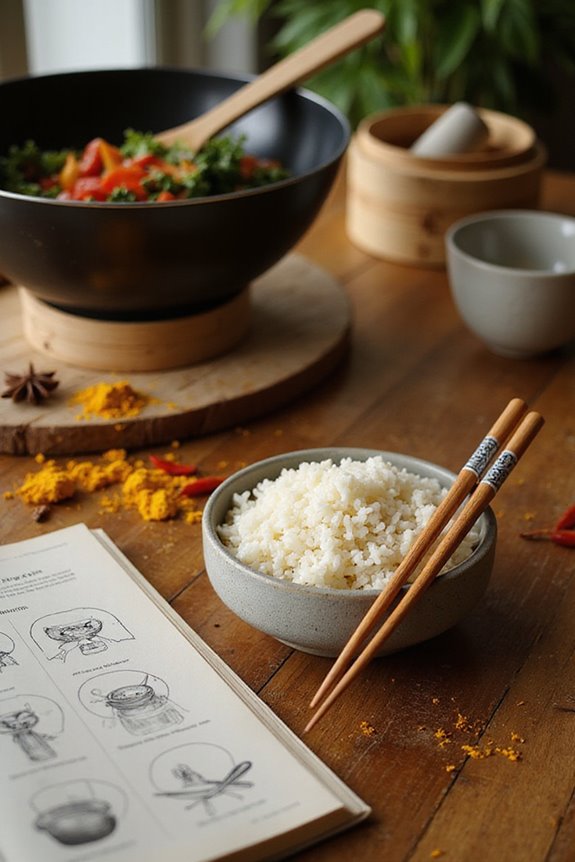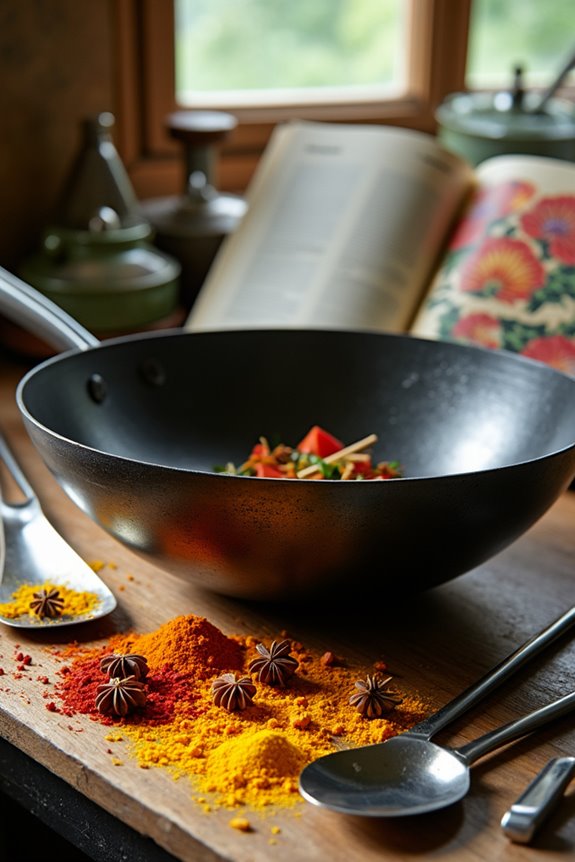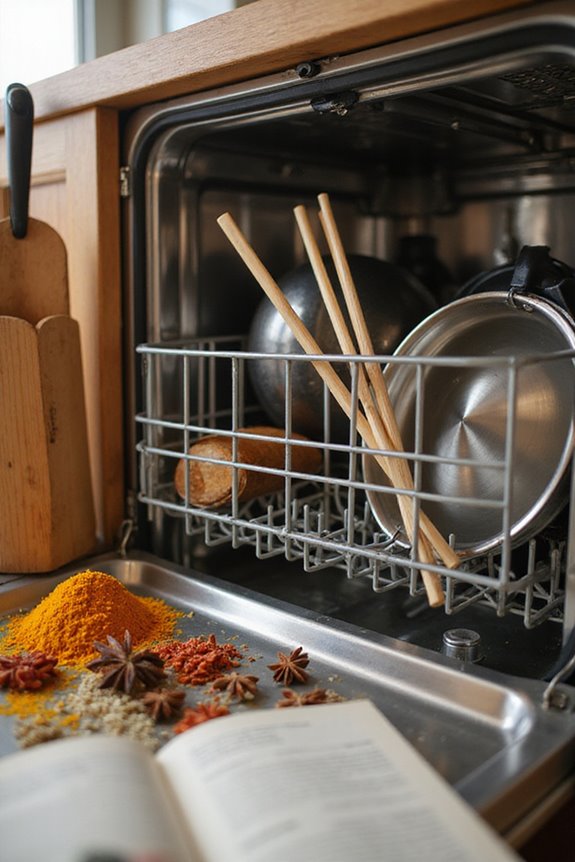To practice chopstick skills, let’s embrace the delightful journey together! Start with understanding the basics: we hold the bottom chopstick in the valley between the thumb and index finger. Next, we can move on to fun exercises, like picking up cotton balls or rice! Avoid common mistakes, like stabbing food, and remember to rest our chopsticks properly. With regular practice, we can master these magical tools, and soon we’ll tackle dishes from different cultures! Excited to learn more tips?
Key Takeaways
- Start with bite-sized and easy-to-grip foods like tofu and eggplant to build initial dexterity.
- Progress to challenging exercises, such as transferring rice or picking up small beans, to refine your skills.
- Use training chopsticks with ergonomic designs to enhance grip and coordination during practice sessions.
- Regularly practice in a social setting to improve skills while fostering connections over shared meals.
- Track your progress and set achievable goals to stay motivated and celebrate your improvements.
Understanding the Basics of Chopstick Holding
When it comes to mastering chopstick skills, understanding how to hold them correctly is the first step toward a delightful dining experience! Let’s immerse ourselves in the magical world of finger placement and hand positioning.
- Bottom Chopstick: It should rest in the valley between the thumb and index finger, touching the side of your ring finger tip. This one stays put, giving us a stable base!
- Top Chopstick: Hold it like a pencil. The thumb pad supports it, while the index and middle fingers control its movement.
Pro tip: Keep your thumb straight and avoid squeezing tight—imagine you’re gently holding a sparkling holiday ornament! Practicing with yummy bite-sized foods will build our skills and get us ready to impress at the dining table! Using training chopsticks can be incredibly beneficial for beginners as they enhance grip and coordination.
Choosing the Right Type of Chopsticks for Practice

Choosing the right type of chopsticks for practice can make all the difference as we plunge into this delightful culinary adventure! Let’s explore material selection and ergonomic features together.
- Wooden chopsticks are classic but can be slippery, while bamboo is lightweight yet fragile.
- Metal chopsticks are tough and easy to clean, perfect for hot dishes.
- If you’re just starting, silicone chopsticks are soft and gentle on your fingers!
We should also consider ergonomic designs, as they help us develop proper technique. Look for training chopsticks with supports or colorful options to make practice engaging! With a bit of trial and error, we’ll find the perfect pair that makes our journey enjoyable and strengthens our skills. Happy practicing! Additionally, using disposable bamboo chopsticks can provide a hygienic way to practice without the worry of cleaning, making your endeavors simpler and more convenient.
Essential Exercises to Improve Dexterity
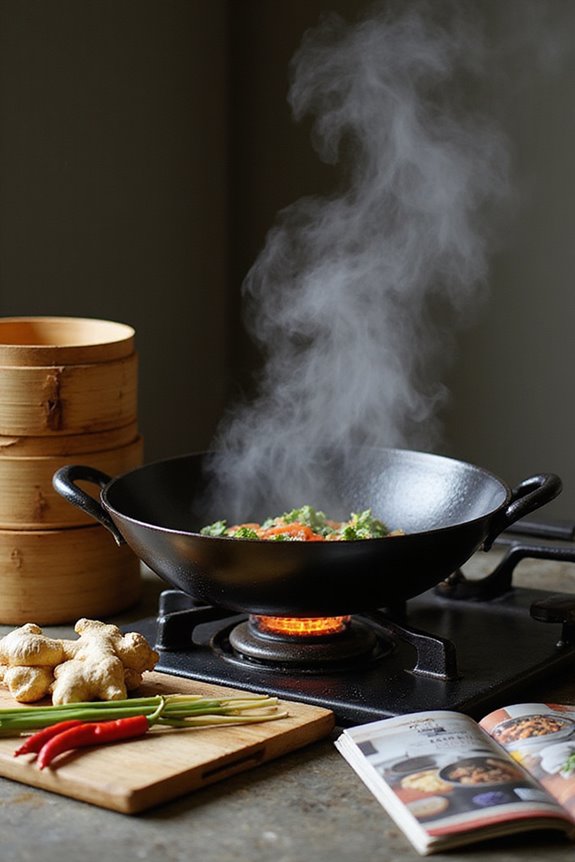
After we’ve selected our perfect pair of chopsticks, it’s time to amp up our skills! Let’s plunge into some delightful dexterity exercises that’ll make us chopstick pros in no time:
- Cotton Ball Challenge: Start picking up cotton balls with chopsticks. Focus on keeping one stick steady to build control.
- Rice Transfer: Fill a bowl with rice grains and practice transferring them between bowls—it’s a little like a magical race!
- Edible Target Practice: Arrange peas or beans on a flat surface, and challenge ourselves to grab them without disturbing the others.
- Noodle Grab: Use long noodles and try grasping them without breaking—what a pasta-fabulous workout!
Interestingly, practicing with extra long chopsticks can enhance your control and precision, allowing for an even more enjoyable experience while mastering these techniques!
With these fun exercises, we’ll boost our fine motor skills and enjoy the process. Let’s get started!
Common Mistakes and How to Avoid Them
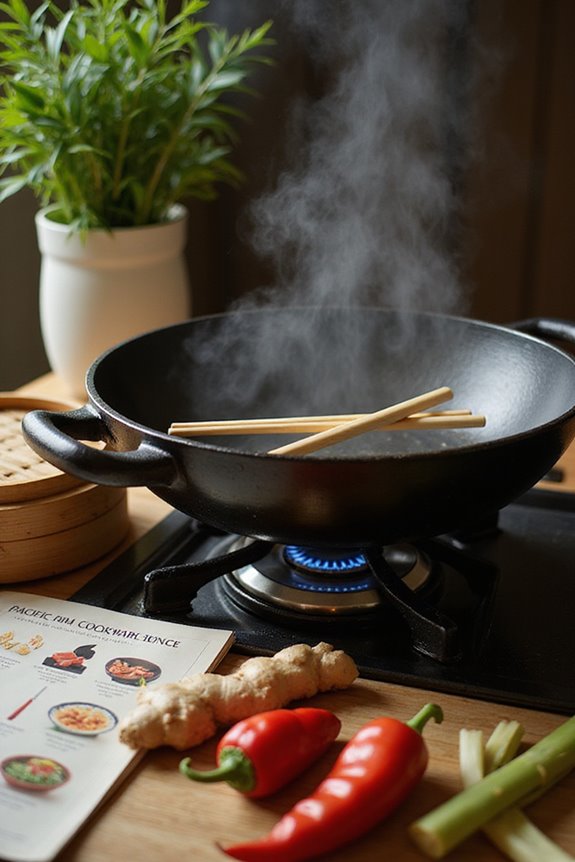
Perfecting our chopstick skills is all about avoiding common pitfalls that can trip us up! First, let’s not hold those chopsticks too close to the ends or we’ll lose control – imagine trying to wrestle a slippery noodle! Also, remember that stabbing food is a no-go; we want to treat chopsticks like delightful tweezers.
Here’s a quick rundown of chopstick etiquette:
- Don’t stick them upright in rice! That’s taboo.
- Rest them parallel on a holder, not crossed.
- Avoid hovering; let’s decide and plunge in! Additionally, using proper ergonomic design can improve comfort and control while you practice.
Tips for Beginners to Start Practicing
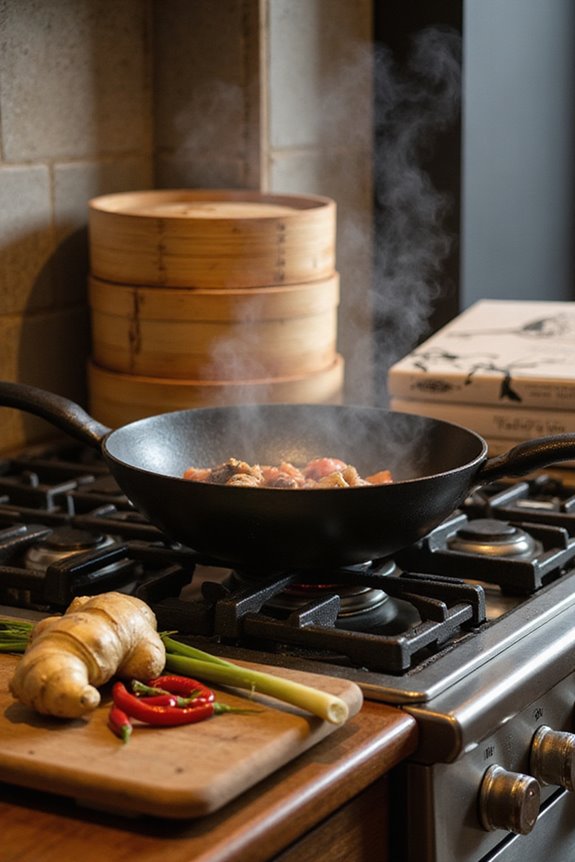
Feeling confident with chopsticks is like mastering a magical skill that opens up a whole new world of culinary delights! To kick off our chopstick journey, let’s nail down finger positioning. We should hold the top chopstick like a pencil, using our thumb, index, and middle fingers. The bottom chopstick will stay steady, supported by our ring finger and the base of our thumb.
Don’t forget to choose chopstick materials that feel good in our hands! As we practice, remember to maintain a relaxed grip and aim for that delightful upward angle. Start with larger items, and work our way down to those trickier morsels. With a sprinkle of patience, we’ll be mastering chopsticks in no time! Additionally, utilizing ergonomic designs can help reduce hand strain and improve our overall grip while we learn.
Practicing With Different Food Items
Practicing with different food items can feel like starting on a delightful culinary adventure! Think of it as a fun challenge where each dish teaches us something new.
- For Beginners: Try tofu and eggplant. Their generous size makes it easy for us to grip as we get the hang of noodle handling.
- Intermediate Fun: Move on to sticky rice and small fruit like grapes for some fruit picking practice. They’ll test our dexterity!
- For a Challenge: Once confident, tackle somen noodles and fried rice. Those slippery bits will really put our skills to the test!
Additionally, using chopsticks can improve fine motor skills and enhance our overall dining experience. Every bite is a chance to improve. So, let’s jump in, have fun, and embrace the joy of mastering chopsticks together!
Advanced Techniques for Mastering Chopsticks
When it comes to mastering the art of chopsticks, there are some delightful advanced techniques that can take our skills from novice to ninja!
Advanced Grip Techniques
Let’s explore variations like the chicken claw grip. Each grip offers a unique way to adapt to different foods.
Dynamic Coordination Drills
How about some fun exercises? Try picking up moving targets or transferring tiny veggies between bowls. These drills boost our coordination and precision!
Using a gentle pinch for slippery foods or practicing slow, deliberate movements can transform us into chopstick champions. So, grab those sticks, and let’s create some chopstick magic together! With regular practice, we’ll handle everything from delicate tofu to lively noodles like pros in no time.
Incorporating Speed Drills Into Your Routine
Incorporating speed drills into our chopstick practice can be a game-changer, especially if we want to elevate our skills and impress our friends at the next potluck! Speed drills are delightful challenges that boost our dexterity and coordination. Here are some fun practice challenges we can try:
- Pick-and-Place Drills: Rapidly grab small items and place them elsewhere.
- Object Transfer Drills: Quickly shift objects from one chopstick to another.
- Time-Based Challenges: Set a timer and see how many items we can pick up in a minute.
As we sprinkle these drills into our daily practice, we’ll notice increased efficiency and fewer errors. Let’s make our chopstick skills magical and enjoy the delightful journey of improvement together!
The Importance of Regular Practice
Mastering chopsticks isn’t just about impressing friends at dinner—it’s a pathway to enhanced motor skills and brain development! Regular practice is essential for skill retention and progress. Here’s why we should make it a delightful routine:
- Practice Frequency: Daily use accelerates improvement. Just think of it as a magical journey; the more we practice, the better we get!
- Finger Isolation: Mastering those finger movements feels rewarding, like unwrapping a present on a festive holiday!
- Contextual Skills: Trying chopsticks during communal dining not only hones our skills but strengthens our bond with others.
Adapting Techniques for Different Cultural Dishes
Have you ever wondered how to adapt our chopstick skills for different cultural dishes? It’s like a flavorful journey around the world! Here are some delightful techniques to master:
Chinese Dishes
- Use larger, flatter foods—think pancakes!
- A firmer grip works wonders.
Japanese Dishes
- Focus on precision for tiny fish bones.
- Use pointed chopsticks for seafood delights.
Korean Dishes
- Metal chopsticks can be a fun challenge!
- Maintain balanced finger placement for control.
Vietnamese Dishes
- Pair chopsticks with a spoon when needed.
- Long chopsticks are your friends for those herb-packed bites.
Southeast Asian Dishes
- Noodle mastery with chopsticks is magical.
- Embrace the cultural adaptations to truly savor every meal.
Let’s make every bite an adventure together!
Frequently Asked Questions
How Long Does It Typically Take to Master Chopsticks?
We journey together toward mastering chopsticks, where practice duration varies, but with persistence, we often see skill improvement bloom within days. Let’s embrace the challenge, knowing confidence’s sweet reward awaits at the end.
Can Children Practice Using Chopsticks Effectively?
Absolutely, kids can practice using chopsticks effectively! We can incorporate chopstick games and fun activities that make learning enjoyable, building their confidence and fine motor skills while fostering a sense of belonging through collaborative dining experiences.
What Are the Health Benefits of Using Chopsticks?
We’ve discovered that using chopsticks enhances our health by promoting mindful eating, improving digestion, and reducing overeating. Embracing chopstick ergonomics and their cultural significance connects us to traditions, fostering unity and shared experiences in meals.
Are There Any Chopstick Competitions I Can Join?
If we’re interested in chopstick tournaments, we should look for local competitive eating events or cultural festivals. Connecting with others who share our enthusiasm can make practicing and participating even more enjoyable and memorable!
What Should I Do if I Experience Hand Pain While Practicing?
If we start feeling hand pain while practicing, let’s remember to take breaks and incorporate hand exercises for pain relief. By caring for our hands, we can enjoy this skill together without discomfort.

